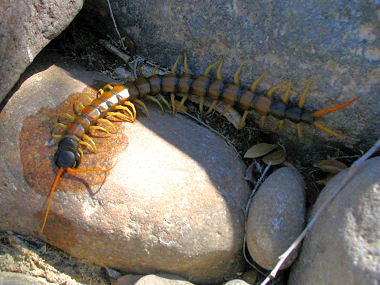Centipedes are arthropods that have
elongated bodies with one pair of legs per segment. They are distant
relatives of lobsters, crayfish, and shrimp. They prefer moist areas,
such as under stones, logs, or leaves. Even though the name means
"hundred legs", the centipede doesn't really have that many; this one
has about 40. The giant desert centipede is one of the world's largest
species of centipede, growing to 6 to 8 inches (15 to 20 cm) long. It
can be identified by its orange body and black head and tail. The bright
coloration advertises the centipede as dangerous. Although the venom
from this centipede is not considered deadly, the Giant Desert Centipede can give
a very painful bite and the venom injected could leave a person in pain
from anywhere between a couple hours to a couple days!
centipede is not considered deadly, the Giant Desert Centipede can give
a very painful bite and the venom injected could leave a person in pain
from anywhere between a couple hours to a couple days!
|
The coloration of the giant
desert Centipede make it difficult to determine which end is the
head. This is a defensive strategy that may confuse predators to
attack the trail, enabling the centipede to get away, or deliver a
nasty bite. |
Centipedes use structures called gnathosomes or
gnathopods to inject venom into their prey. These are paired pincer-like
appendages in front of the legs. The “bite” is actually a pinch.
Centipedes are fast-moving predators that feed on any small creatures
they can catch - mostly insects, but occasionally other arthropods,
lizards, and even small rodents. These fast-moving predators are more
prone to drying out than many other species, so they are only active at
night. Centipede mothers care for their eggs, coiling around them and
grooming them. This grooming is thought to protect against mold and
bacteria. Once the young hatch, the mother tends them as she did the
eggs, until they disperse a few days later. Some centipedes have been
known to live for up to 6 years. |

